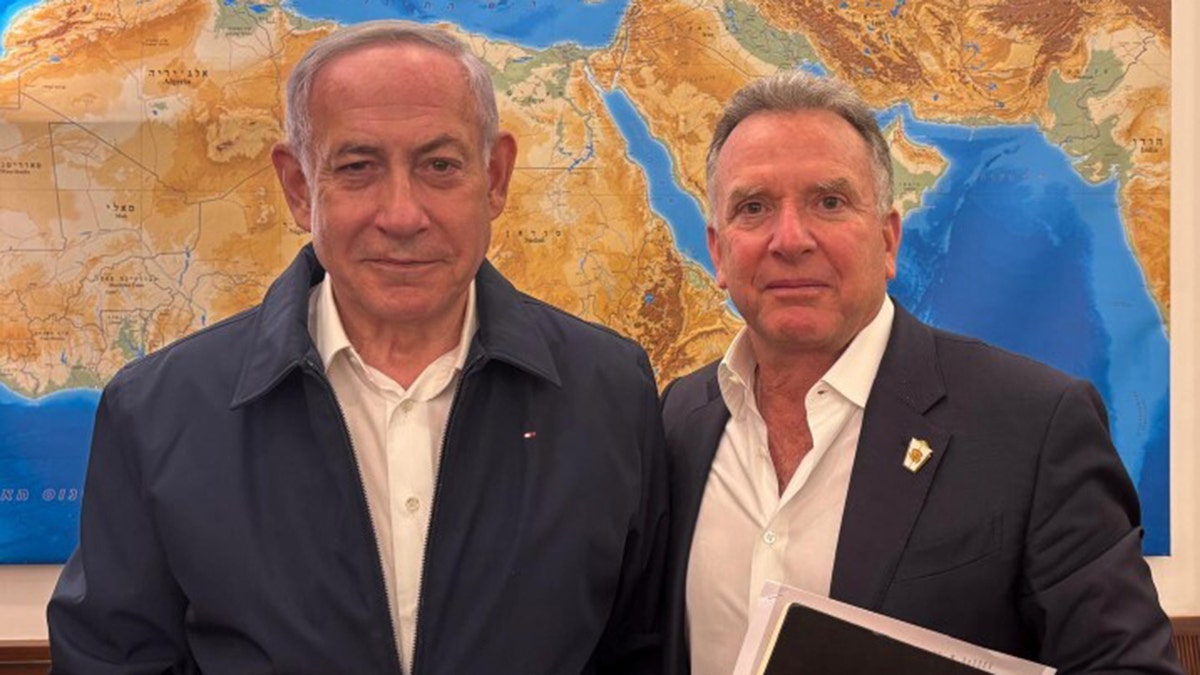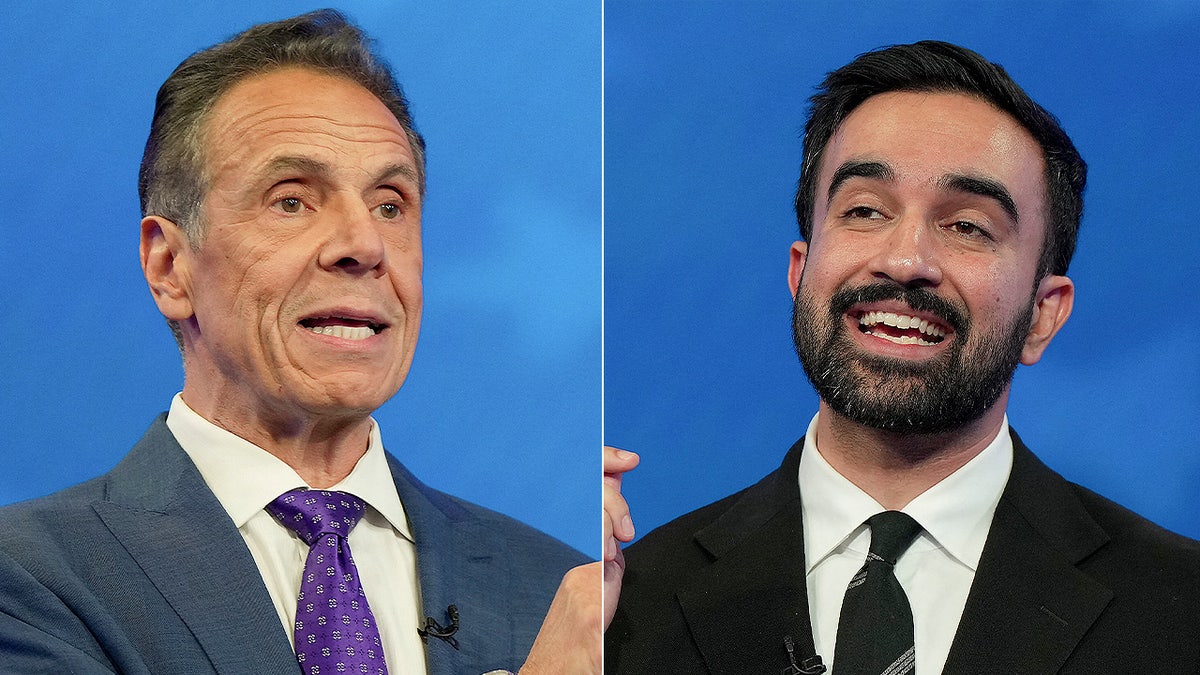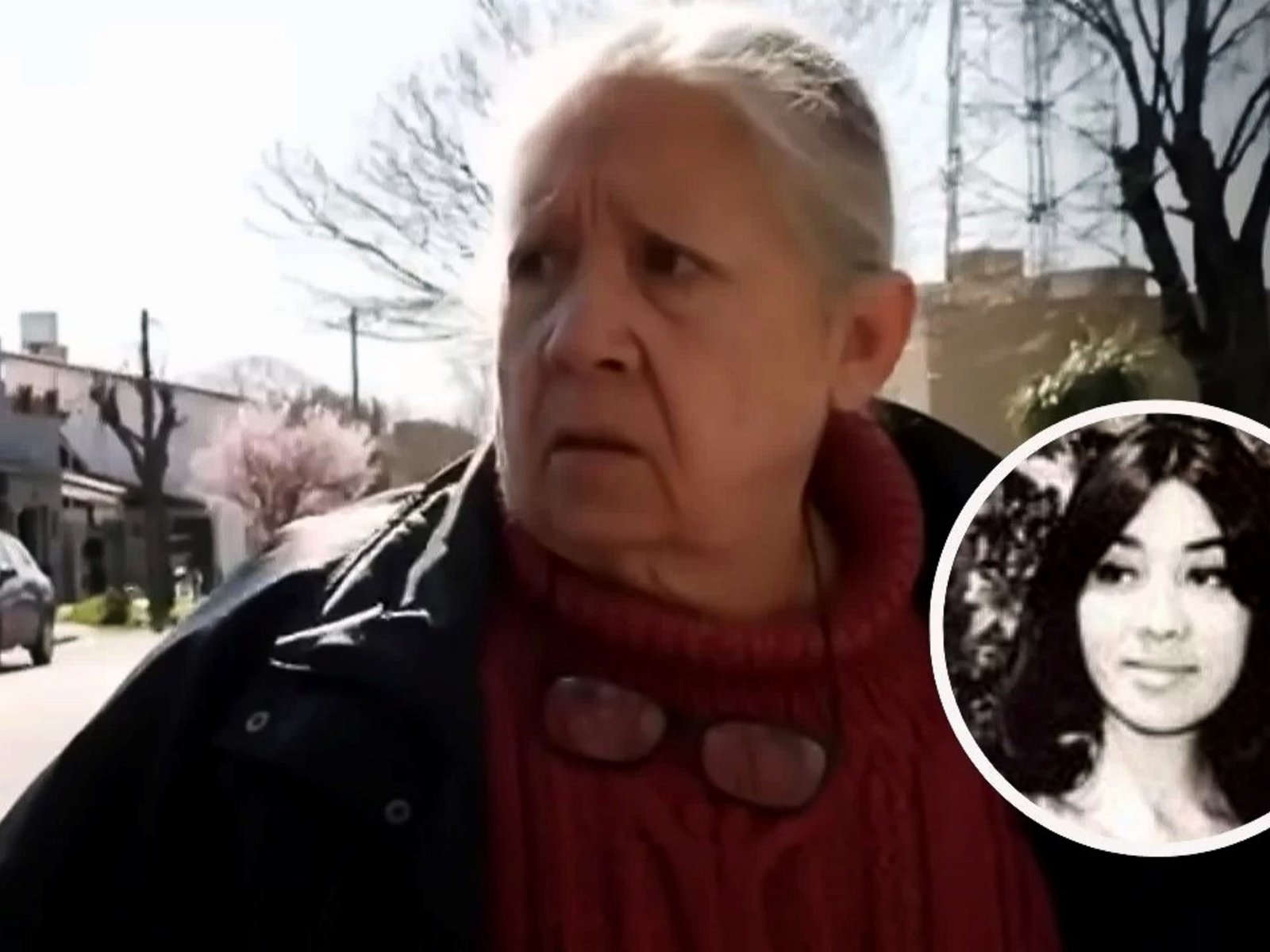INTERNACIONAL
Hamas ‘hardens’ stance in ceasefire talks as Netanyahu recalls negotiation team

NEWYou can now listen to Fox News articles!
Ceasefire negotiations between Israel and the Hamas terrorist organization hit a setback Thursday, as Prime Minister Benjamin Netanyahu recalled Israel’s negotiating delegation from Doha following what officials described as a hardening of Hamas’ demands.
«In light of the response Hamas delivered this morning, it has been decided to recall the negotiating team for further consultations in Israel,» the Prime Minister’s Office said in a statement. «We appreciate the efforts of the mediators, Qatar and Egypt, and the efforts of envoy Steve Witkoff to achieve a breakthrough in the talks.»
According to reports in Israeli media, the terror group is now demanding the release of 200 Palestinians serving life sentences for murdering Israelis, and an additional 2,000 Palestinians detained in Gaza after Oct. 7. That demand significantly exceeds the previous mediator-backed framework – reportedly accepted by Israel – which included the release of 125 life-term prisoners and 1,200 other detainees.
HUCKABEE HITS BACK AT WESTERN COUNTRIES THAT ‘SIDE’ WITH TERROR GROUP HAMAS
Palestinians carry aid supplies from the U.S.-backed Gaza Humanitarian Foundation, in Khan Younis, in the southern Gaza Strip, May 29, 2025. (Reuters/Hatem Khaled)
«The return of the delegation is not a collapse or a crisis, but the gaps are significant and present across all core issues,» a senior Israeli official told Channel 12. Another official confirmed to U.S. Middle East envoy Steve Witkoff that Hamas’ updated prisoner exchange terms are «unacceptable.»
A joint statement by 25 countries condemning Israel’s conduct in Gaza may have further complicated already fragile ceasefire negotiations, Israeli officials suggested. In response to the condemnation, Israel’s Foreign Ministry issued a sharply worded statement, warning, «At these sensitive moments in the ongoing negotiations, it is better to avoid statements of this kind.
«Israel rejects the joint statement published by a group of countries, as it is disconnected from reality and sends the wrong message to Hamas.» The ministry added that «all statements and all claims should be directed at the only party responsible for the lack of a deal for the release of hostages and a ceasefire: Hamas, which started this war and is prolonging it.»
Hostage families expressed deep concern about the breakdown in negotiations. «The families are watching with concern as reports emerge about the negotiating team’s return,» the Hostages and Missing Families Forum said in a statement. «Every day that passes endangers the hostages’ chances of recovery and the ability to locate the dead. Another missed opportunity to bring everyone home would be unforgivable – a moral, security, and diplomatic failure.»
The negotiations, which have dragged on for weeks, are part of a proposed U.S.-backed deal involving a 60-day ceasefire in exchange for the release of some 50 remaining Israeli hostages, a phased release of Palestinian prisoners and expanded humanitarian aid to Gaza.

Hamas terrorists take up positions ahead of a hostage release in Deir al-Balah, central Gaza Strip, Feb. 8, 2025. (AP)
Hamas is also demanding that Israeli troops withdraw to positions held before March 2, when the last ceasefire collapsed, and that the Rafah crossing between Gaza and Egypt reopen in both directions. The group further opposes the newly established U.S.-backed Gaza Humanitarian Fund, demanding that aid distribution return to the previous U.N.-supervised mechanism.

Relatives and supporters of Israeli hostages held captive in the Gaza Strip since the Oct. 7 attack in southern Israel hold their portraits at Hostages Square in Tel Aviv on May 28, 2025, to mark 600 days of their captivity and demand their release and an end to the war. (Ahmad Gharabli/AFP via Getty Images)
A Hamas official told Reuters the group is insisting on a return to a Jan. 19 protocol for aid entry, and that ceasefire negotiations must include a clause preventing Israel from resuming military operations after the 60-day truce – even if a broader deal is not reached.
At the center of the deadlock is the growing humanitarian crisis. The U.N. and international aid groups warn that hundreds of thousands of people in Gaza face severe food insecurity. It is claimed that civilians in the north have been forced to survive on animal feed and foraged plants, while chaotic aid distributions in the south have repeatedly turned deadly.

Lt. Gen. Eyal Zamir, the chief of the General Staff, conducts a field tour in the Rafah area of the Gaza Strip. (IDF)
ISRAEL ACCEPTS TRUMP-LED CEASEFIRE PLAN THAT COULD END GAZA WAR WITHIN 60 DAYS
In response to mounting pressure, Israel is visibly increasing the pace of aid deliveries. On Thursday, COGAT (Coordinator of Government Activities in the Territories) reported that 70 aid trucks were transferred into Gaza on Wednesday through the Zikim and Kerem Shalom crossings. The shipments, primarily food, were delivered under IDF coordination with the U.N. and humanitarian organizations.
COGAT said more than 150 trucks were collected inside Gaza, but warned that over 800 trucks remain uncollected at the crossings due to logistical breakdowns on the Palestinian side.
The Gaza Humanitarian Foundation (GHF) stated on X that it offered on Wednesday to deliver the U.N.’s tons of aid sitting in Gaza for free. John Acree, GHF’s interim director, said, «We’ve seen aid by the U.N. and other organization(s) being piled near the borders but not being delivered.»

Prime Minister Netanyahu meets with Steve Witkoff, special envoy to the Middle East. (Prime Minister’s Media Adviser)
Israeli journalist Nadav Eyal reported Thursday that senior defense officials say they’ve been instructed by the political echelon to «greatly speed up the entry of humanitarian aid into Gaza» and to «be less concerned with precautions or plans to keep it out of Hamas’ hands.»
CLICK HERE TO GET THE FOX NEWS APP
As talks stall and military activity resumes, Israeli officials warn that the window for a deal may be closing. «There are still significant gaps,» one source told Channel 12. «The negotiations are not over – but time is running out.»
INTERNACIONAL
Bruce Springsteen tiene su película película biográfica, pero no es la que se podía esperar

Durante meses del año pasado, Jeremy Allen White tuvo a Bruce Springsteen hablándole constantemente al oído.
White escuchó una y otra vez la narración en audio de 18 horas de las memorias de Springsteen, Born to Run, como parte de una intensa preparación para interpretarlo en la próxima película Springsteen: música de ninguna parte, que narra las dificultades del ícono del rock para crear su álbum Nebraska en 1982.
“Eso sonaba en casa todo el tiempo”, recordó White, conocido por ser el protagonista de la serie The Bear, en una reciente entrevista por video. “Cuando salía a correr, cuando caminaba, cuando preparaba la cena. Me ayudaba mucho tener su voz conmigo todo el tiempo”.
Springsteen: música de ninguna parte, escrita y dirigida por Scott Cooper (Crazy Heart), ofrece algunos momentos propios de la épica biográfica del rock, como un White empapado en sudor cantando “Born to Run” ante una multitud o improvisando para un público devoto en el club Stone Pony de la costa de Nueva Jersey.
Pero al centrarse en Nebraska —una galería de personajes frágiles en clave acústica— y el colapso depresivo que Springsteen atravesó tras su grabación, la película se convierte en una exploración sobre la fragilidad de la salud mental y los límites del arte como sostén vital. En una escena tomada directamente de las memorias del músico, el hombre generalmente visto como el ideal del rock entra en la consulta de un terapeuta y rompe a llorar en silencio.
El objetivo de Cooper, dijo, “nunca fue contar la historia completa de Bruce Springsteen”. “Me esforzaba por hacer algo más tranquilo y más interior, sobre este momento muy específico en la vida de Bruce”, añadió el director, “sobre un hombre que enfrenta algunos de los traumas que arrastra desde su infancia”.
Springsteen: música de ninguna parte marca la primera vez que “El jefe” permite que su historia sea dramatizada en una película, y no es casualidad que Nebraska sea el núcleo. Springsteen ha dicho que considera este álbum quizás el mejor, aunque siempre ha sido una rareza y un misterio en su obra.
Compuesto mientras comenzaba a trabajar las canciones que dos años después integrarían Born in the USA, Springsteen grabó Nebraska en solitario, con una grabadora simple de cuatro pistas, en una casa alquilada en Colts Neck, cerca de Freehold, en Nueva Jersey. El músico trabajó en ella durante los meses posteriores a la exitosa gira de The River, su primer álbum número uno, bajo la presión de sostener su popularidad.

Las grabaciones de temas como “Atlantic City”, “Johnny 99″ y “Nebraska” —relatos de crimen, soledad y personajes en busca de esperanza— fueron concebidas como maquetas a desarrollar junto a la E Street Band. Pero Springsteen quedó cautivado por el sonido crudo y fantasmal de las cintas, y tras intentos frustrados de rehacerlas en el estudio, decidió que la versión original saldría tal cual, a pesar de la escasa fidelidad. En la película, los productores lidian con la dificultad de convertir el casete en un master comercialmente viable.
Para la discográfica y su entorno, fue una decisión desconcertante y arriesgada para un artista en ascenso; una jugada que, bajo la mentalidad común de la industria, podía suponer un freno a su carrera. Springsteen incluso insistió en que Nebraska no fuese promocionado con sencillos, giras ni entrevistas.
Warren Zanes, músico y académico que conoció Nebraska siendo un adolescente en la banda Del Fuegos en los años 80, afirmó que, aunque ama el disco, siempre le costó entenderlo como cambio de rumbo:“Fue, para mí, uno de los mayores giros a la izquierda en la historia de la música popular”.
Tras leer la descripción de Nebraska en las memorias de Springsteen, seguida de un relato profundo de una crisis emocional, Zanes comenzó a escribir un libro sobre el álbum, entrevistando a Springsteen y a su mánager de toda la vida, Jon Landau. Ese libro, titulado Deliver Me From Nowhere (Líbrame de la nada, título original en inglés de la película también) se publicó en 2023 y Cooper lo utilizó como base para el guion.

La película retrata a Springsteen en este periodo como un personaje solitario y atribulado, pero productivo, inspirado en el filme Badlands (Malas tierras) de Terrence Malick (1973), el dúo punk Suicide y su propia biografía. Springsteen compone las canciones de Nebraska mientras revive recuerdos de infancia ligados a su padre, melancólico y bebedor, que aparece en un flashback en blanco y negro. Surge una relación con Faye, una madre soltera de Nueva Jersey, pero el músico no logra comprometerse con ella. (Faye, figura compuesta, es el único personaje principal que no está basado en una persona real).
“Bruce estaba obsesionado, no en lo gótico, sino en lo espiritual”, explicó Cooper, usando una gorra de Stone Pony. “Creo que lo obsesionaba su padre, emocionalmente distante, ese mito estadounidense de quienes persiguen el sueño americano y no lo logran”.
Cooper indicó que tanto él como Springsteen decidieron no construir una hagiografía, sino mostrar las luchas y fracasos del artista, además de sus logros. “No me interesaba mitificarlo”, declaró el director. “No estaba persiguiendo al Jefe. Busco al hombre solo en una habitación en Colts Neck con una grabadora tratando de darle sentido a su vida y a sus traumas”.
Las vivencias de Springsteen con la depresión, antes poco conocidas, se hicieron públicas en sus memorias de 2016. La relación con su padre ocupó un lugar central en Springsteen on Broadway, su espectáculo de 2017.

“Hace mucho tiempo, las defensas que construí para soportar el estrés de mi infancia, para salvar lo que tenía de mí mismo, dejaron de ser útiles”, escribió Springsteen en ese libro. “Me basé en ellas para aislarme, sellar mi alienación, aislarme de la vida, controlar a los demás y contener mis emociones hasta un punto perjudicial. Ahora el cobrador llama a la puerta, y su pago será en lágrimas”.
Cooper aseguró que White fue la única opción para el papel principal. “Pensaron que podía expresar una historia compleja con calma y mucha intensidad física”, dijo el protagonista.
El actor dudó. El papel exigía interpretación musical, pero White no era cantante ni había tocado guitarra. “Le dije: ‘Me gustaría hacer esto contigo, adoro a Bruce, ¿pero no prefieres a alguien que ya sepa hacerlo?’”.
Hasta que Cooper le transmitió que Springsteen mismo quería que lo interpretara. “En ese punto pensé: ‘No voy a interponerme en su camino’”.
Durante seis meses, White estudió guitarra y tomó clases diarias de canto con Eric Vetro, entrenador vocal de celebridades, responsable de la preparación de Austin Butler en Elvis y de Timothée Chalamet para Un completo desconocido.
En la película, la voz de White se escucha cuando canta en pantalla; en otras escenas es la voz de Springsteen.

Se ve a White con cabello desordenado, hombros musculosos encorvados en una campera de cuero negro, conduciendo un Camaro Z28 por las carreteras de Nueva Jersey, una imagen del Jefe de unos 30 años que sorprendió a sus compañeros de elenco.
“Se concentró por completo”, dijo Odessa Young, quien encarna a Faye. “Está muy presente y concentrado, y verlo interpretar a Bruce resultó casi inquietante”.
Gran parte del filme gira en torno a la relación casi fraternal de Springsteen con Landau, inicialmente crítico musical que luego se convirtió en su mánager y productor. Su colaboración histórica, desde 1975, es una de las más largas y exitosas del rock.
Jeremy Strong (Succession, El Aprendiz) interpreta a Landau como un artista empático y pragmático. Al oír Nebraska por primera vez, el representante intenta comprender la música y el dolor de su cliente. “Tiene una sensibilidad magistral”, señaló Strong sobre Landau.
Pero Landau sabe que hay un límite a su ayuda. En un momento crucial, Springsteen llega a una casa vacía en Los Ángeles y llama a Landau, quien le dice: “Necesitas ayuda, ayuda profesional”. El músico inicia terapia, a la que atribuye un cambio vital.
Persisten ciertas tensiones, sobre todo con la presión de la discográfica CBS respecto al lanzamiento de Nebraska. Finalmente, Landau y Springsteen salieron fortalecidos. Nebraska alcanzó el número 3 y fue celebrada por la crítica. Su álbum siguiente, Born in the USA, consagró a Bruce Springsteen como superestrella mundial.

Cooper optó por no dramatizar la negociación con CBS, evitando el cliché del conflicto entre artista y sello discográfico y enfocándose en la relación entre Springsteen y Landau. “Es una historia de amor entre estos dos hombres”, afirmó.
“La experiencia de Jon en la película pone a prueba su fe y determinación respecto a la visión de Bruce”, opinó Strong. “Aparecen imperativos comerciales versus imperativos artísticos y espirituales. En la vida real, Jon Landau jamás hubiera elegido lo primero”.
Springsteen y Landau aprobaron la realización de la película y Cooper dijo que ninguno de los dos pidió cambios. “Dejamos claro que era su historia”, afirmó Landau. “No solicitamos ni recibimos control sobre la filmación, el guion, la edición, el reparto, la música ni otro aspecto”. Agregó: “A mi juicio, es una de las mejores decisiones que hemos tomado”.
El rodaje comenzó en septiembre de 2024 y siguió hasta enero de 2025, mientras Springsteen realizaba su última gira. Él y Landau fueron presencias habituales en el set. “Casi todas las noches”, contó White, “recibía mensajes de texto de Bruce acerca de algún momento del rodaje que él sentía fiel a las emociones que vivió de joven”.
“Esos mensajes”, añadió, “me marcaron”.
Fuente: The New York Times
[Fotos: prensa The Walt Disney Company]
20th century studios,jeremy strrong,jon landau,springsteen: deliver me from no
INTERNACIONAL
Sparks fly as Cuomo, Mamdani tear into each other during fiery debate: ‘Toxic energy’

NEWYou can now listen to Fox News articles!
Front-runners for New York City mayor, Zohran Mamdani and Andrew Cuomo, wasted little time attacking each other on alleged personal scandals they have been involved in during a Wednesday night debate between the pair and GOP candidate Curtis Sliwa.
Mamdani and Sliwa took the opportunity during Wednesday’s debate to drill down on past sexual harassment allegations against Cuomo, the former governor of New York, ahead of an impeachment inquiry that preceded Cuomo’s 2021 resignation. Cuomo was also hit by Mamdani over accusations he has – while in public office – failed to meet with Muslim constituents and only began doing so amid pressure from his mayoral campaign, and over his alleged poor handling of the COVID-19 virus in New York after Cuomo was party to issuing guidance forcing nursing homes and long-term care facilities to admit COVID-19 positive patients.
Meanwhile, Cuomo did not hold back on targeting Mamdani over alleged controversies that have embattled his campaign. Cuomo blasted the self-proclaimed socialist over his lack of experience, ties to radical politics, and past radical comments about law enforcement, Israel and the situation in Gaza.
FBI AGENTS FROM ’93 WTC ATTACK BLAST MAMDANI FOR EMBRACING RADICAL IMAM
All three candidates for NEw York City governor debated Wednesday night. From left to right: Andrew Cuomo, Curtis Sliwa and Zohran Mamdani. (Photo by Angelina Katsanis-Pool/Getty Images)
«My main opponent has no new ideas. He has no new plan. … He’s never run anything, managed anything. He’s never had a real job,» Cuomo said of Mamdani during the debate. Cuomo also branded Mamdani as someone who has proven to be «a divisive force in New York,» pointing to past incidents that have garnered Mamdani heat from critics.
One of those incidents included a picture he took with a hard-lined Ugandan lawmaker who has pushed policies of imprisoning people for being gay, which Mamdani took while taking a break from the campaign trail to visit his home country of Uganda for a wedding. Cuomo also hit the controversy over whether Mamdani supports Jewish New Yorkers, as his critics have claimed he is anti-Israel pointing to statements he has made, like «globalize the intifada.»
Cuomo also accused Mamdani of disrespecting Italian-Americans after a video of him surfaced giving the middle finger to a statue of Christopher Columbus, while also pointing to criticism the self-proclaimed socialist candidate has garnered from 9/11 first-responders after posting a photo with a Muslim cleric who served as a character witness for the mastermind behind the September 11, 2001 attacks.
TOP 5 MOMENTS FROM FIERY NYC MAYORAL DEBATE: ‘HE LITERALLY HAS NEVER HAD A JOB’

Former New York Governor Andrew Cuomo (left) shakes hands on the debate stage with Democratic Party candidate for New York City mayor (right) Zohran Mamdani. Cuomo is running as an Independent after lsoing to Mamdani in the primary election. (Photographer: Angelina Katsanis/AP)
«You have been a divisive force in New York, and I believe that’s toxic energy for New York. It’s with the Jewish community. It’s with the Italian-American community – when you give the Columbus statue the finger. It’s with the Sunni Muslims when you say decriminalize prostitution, which is Haram. It’s the Hindus,» Cuomo continued. «Then, you take a picture with Rebecca Kadaga, deputy Prime Minister of Uganda. … She’s known as Rebecca ‘Gay Killer.’ … You’re a citizen of Uganda. You took the picture. You said you didn’t know who she was. It turns out you did. How do you not renounce your citizenship or demand BDS against Uganda for imprisoning people who are gay just by their sexual orientation? Isn’t that a basic violation of human rights?»
Mamdani shot back that his politics have remained «consistent» and that they are built on a belief in human rights for all people, including LGBTQ+ folks. Had he known Kadga’s role in drafting legislation to imprison gay folks, Mamdani said, he never would have taken the picture.
«This constant attempt to smear and slander me is an attempt to also distract from the fact that, unlike myself, you do not actually have a platform or a set of policies,» Mamdani shot back at Cuomo before introducing his own claims about the former governor regarding past accusations of sexual harassment.
MAMDANI RIPPED BY RIVALS FOR UNPOPULAR STANCE DURING FIERY NYC DEBATE: ‘YOU WON’T SUPPORT ISRAEL’

New York City mayoral candidate Andrew Cuomo slammed his democratic socialist opponent Zohran Mamdani during Wednesday’s debate for a variety of alleged scandals he has been involved in. (Angelina Katsanis/Getty; Angelina Katsanis/Getty)
«Mr. Cuomo. In 2021, 13 different women who worked in your administration credibly accused you of sexual harassment. Since then, you have spent more than $20 million in taxpayer funds to defend yourself, all while describing these allegations as entirely political,» Mamdani said while attacking Cuomo Wednesday night.
«You have even gone so far as to legally go after these women. One of those women, Charlotte Bennett, is here in the audience this evening. You sought to access her private gynecological records. She cannot speak up for herself because you lodged a defamation case against her. I, however, can speak. What do you say to the 13 women that you sexually harassed?»
Cuomo, in 2021, was accused of multiple incidents of sexual harassment that preceded his resignation as governor that year. A subsequent report from New York Attorney General Letitia James confirmed Cuomo «sexually harassed multiple women from 2013 through 2020,» while in January 2024, the U.S. Department of Justice announced it had reached a nearly $500,000 settlement with Cuomo’s executive office over one of the claims. However, no criminal charges were ever filed against Cuomo, with some district attorneys citing insufficient evidence.
CLICK HERE TO GET THE FOX NEWS APP
Cuomo defended himself against Mamdani’s accusations, noting the cases were eventually dropped, before returning to questions about Mamdani’s alleged past.
Meanwhile, Sliwa didn’t skip an opportunity to slam Cuomo over the sexual assault allegations either, saying early in the debate during a discussion about homelessness that Cuomo «fled» the governor’s office amid an impeachment inquiry that was investigating him.
«Andrew, you didn’t ‘leave.’ You fled from being impeached by the Democrats in the state legislature,» Sliwa began before getting into the homelessness issue, earning him a round-of-applause from the audience.
«‘Leave?’ You fled!» Sliwa continued to applause. «But let’s get back on topic.»
elections state and local,2025 2026 elections coverage,andrew cuomo,zohran mamdani,nyc mayoral elections coverage
INTERNACIONAL
Ahora la Justicia de Chile investigará el caso de Bernarda Vera, la desaparecida que encontraron viviendo en Argentina

Tres semanas después del revuelo político generado en Chile por el presunto hallazgo en Argentina de Bernarda Vera, una mujer que integraba el listado oficial de víctimas de la dictadura militar de Augusto Pinochet, la Justicia chilena abrió una investigación para dar con su paradero.
La causa fue radicada el Primer Juzgado del Crimen de Temuco, en la región de La Araucanía, y quedó bajo secreto de sumario. El caso lo lleva adelante el ministro de la Corte Álvaro Mesa, especialista en causas de violaciones de los derechos humanos.
Video
Así fue el encuentro entre las cámaras de TV y la mujer que podría ser Bernarda Vera
A través de un escrito, el funcionario afirmó que «hasta hace pocos meses no existían causas vigentes respecto a los delitos de desaparición forzada, secuestro o detención ilegal de Bernarda Vera Contardo«, nombre que figura entre las 1.162 personas incluidas en el Informe de la Comisión Verdad y Reconciliación (Rettig).
El panorama cambió, según el portal Bio Bio Chile, ante el surgimiento de algunas «incongruencias en los relato» que fueron reportadas por el Plan Nacional de Búsqueda (PNB) del Programa de Derechos Humanos» y derivaron en la apertura de «un cuaderno de búsqueda».
La protagonista de la historia es Bernarda Vera, una profesora que, con 27 años y una hija de 5, fue detenida por militares el 10 de octubre de 1973 y que, aparentemente, había sido ejecutada en el puente de Villarrica, también en la región de La Araucania. Sin embargo, el caso dio un giro a fines de septiembre cuando salió a la luz una investigación periodística que habría ubicado a quien fuera militante del Movimiento de Izquierda Revolucionaria (MIR) en la localidad bonaerense de Miramar.
Desde el gobierno de Gabriel Boric fue el ministro de Seguridad, Luis Cordero, quien señaló que la tarea de «corroborar científicamente la identidad de la mujer que vive en Argentina y que sería Bernarda Vera» le corresponde efectivamente al juez que tramita la causa.
La consulta al funcionario se debe a que fue quien estaba al frente del Ministerio de Justicia y Derechos Humanos cuando se puso en marcha el Plan Nacional de Búsqueda, Verdad y Justicia y es el señalado por la oposición como el responsable de la eventual «inexactitud respecto al caso».
Conocida como «Anita» en sus tiempos de militancia en el MIR, Bernarda Vera figura en el Informe Rettig, el registro de las víctimas de violaciones a los derechos humanos durante la dictadura pinochetista. Testimonios que quedaron fuera de la causa y algunos detalles del boletín que cada mes publica el PNB dieron indicios de que la mujer podría haber escapado de ese destino.
El reporte que se difundió en septiembre mencionó que «en algunos casos, muy excepcionales, este proceso ha revelado incongruencias con las conclusiones de las Comisiones de Verdad. Un primer caso refiere a una persona, condenada a muerte por un Consejo de Guerra en 1973, que fue calificada por la CNVR (Comisión Rettig), con los antecedentes disponibles en la época como víctima de desaparición forzada”.
Video
El momento en el que un informe de TV encontró a Bernarda Vera, la supuesta desaparecida chilena que vive en Argentina
“Posteriormente, el PNB recogió testimonios de personas que dijeron haberla visto fuera de Chile después de la fecha en la que la CNVR estableció su desaparición. A raíz de ello, se abrió una investigación administrativa respecto de su trayectoria. Estos antecedentes fueron puestos en conocimiento del Comité de Seguimiento y Participación del Plan Nacional de Búsqueda; de la familia de manera reservada para proteger su privacidad; y al mismo tiempo, se ofició oportunamente al Ministro en Visita Extraordinaria con competencia en la causa”, detalla el documento.
Esos datos fueron parte de la investigación periodística de Chilevisión, que condujo a una de sus cronistas a la ciudad de la costa bonaerense y donde habría dado con el paradero de Bernarda Vera Contardo, quien detrás de la puerta de su casa se negó a hablar con la periodista. El tema generó un fuerte debate en el país y desató fuertes críticas a la administración del Frente Amplio.

 CHIMENTOS3 días ago
CHIMENTOS3 días agoPampita recibió un video inesperado de su hija Blanca en el Día de la Madre y no pudo contener la emoción

 POLITICA3 días ago
POLITICA3 días agoDonald Trump habló sobre la ayuda económica de Estados Unidos: “La Argentina está peleando por su vida”

 DEPORTE15 horas ago
DEPORTE15 horas agoUniversidad de Chile vs. Lanús, por la Copa Sudamericana: día, horario y cómo verlo por TV















